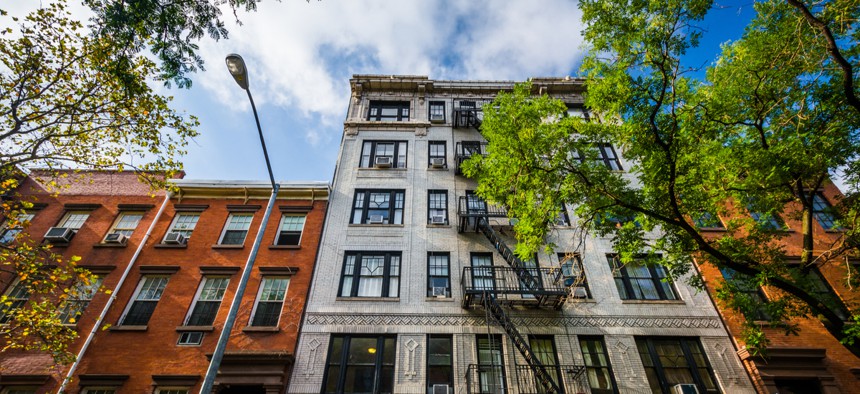What a Trillion-Dollar Housing Pledge Looks Like

Every state, county, and metro area faces a shortage of affordable housing. Shutterstock
Representative Ilhan Omar’s Homes for All Act would fund the construction of 12 million new homes in the U.S. over 10 years, mostly as public housing.
Minnesota Representative Ilhan Omar introduced a bold act on Thursday that would commit $1 trillion to the cause of affordable housing. That’s trillion with a T, which makes Omar’s bill a new milemarker in the progressive left’s efforts to stake out a national housing agenda.
Housing has emerged as a pressing issue on the campaign trail, and it surfaced as a concern during the Democratic Party forum on Wednesday night. Several candidates discussed their plans on topics such as zoning, rent relief, and racial segregation. Massachusetts Senator Elizabeth Warren spoke to the history of redlining, while New Jersey Senator Cory Booker mentioned his plan for a tax credit for renters. Yet a separate idea is brewing on the left. Housing is a litmus for liberals, as as a younger generation of progressives embraces a solution abandoned by elected officials after decades of systemic failures: public housing.
Omar’s Homes for All Act plants a flag for an unapologetic public housing agenda. Her bill would authorize funding for 12 million new homes over 10 years, most of which would take the form of public housing. It would mark the first commitment to public housing since the Clinton era, when Congress shredded this part of the social safety net. It speaks to the growing dissatisfaction among tenants and advocates with neighborhood change. In many cities, proven approaches to rental affordability—namely building more homes everywhere—have fallen short.
The figures spelled out by the Homes for All Act are staggering: $80 billion for public housing agencies every year through 2031 (for a total of $800 billion) to fund the construction of 9.5 million new public housing units. Another $20 billion each year ($200 billion over 10 years) would go toward the federal Housing Trust Fund, an Obama-era program to provide affordable housing for the very poorest families in the nation.
In another signal of a generational sea change on social programs, Omar isn’t just looking to build more public housing. She wants to transform it into something like an entitlement. The bill would make it mandatory for government to actually pay all the costs associated with the maintenance and operation of public housing. That’s a provision to guarantee future spending and a significant shift from the status quo: Costs for deferred maintenance for public housing will reach at least $90 billion by 2030.
The Homes for All Act sets out a variety of requirements for these newly provisioned affordable homes, including access to public transit, childcare, and other services. And by putting public housing on a similar footing with safety-net pillars like Social Security and unemployment insurance, Omar’s bill would ensure that new public housing never again falls in the awful state of disrepair seen in many projects today.
On top of a trillion dollars for housing, Omar’s bill establishes a new Community Control and Anti-Displacement Fund—a $200 billion appropriation under the U.S. Department of Housing and Urban Development. The purpose of the fund, which might be the first federal housing proposal to specifically call out gentrification as a crisis, is to “provide grants to local governments for the purposes of combating gentrification and neighborhood destabilization.” The section outlining the fund runs fewer than 100 words, so there’s room for the congresswoman to explain what she means by gentrification.
The Homes for All Act comes just days after the Green New Deal for Public Housing Act was introduced by Omar’s fellow freshman congresswoman and Squad member New York Representative Alexandria Ocasio-Cortez. That bill, which AOC launched with Vermont Senator Bernie Sanders amid cheering tenants’ rights advocates in a rally outside the U.S. Capitol last week, proposes rebuilding the nation’s public housing stock through billions of dollars in energy retrofits. It would also commit billions to meet the government’s deferred maintenance bills and decarbonize public housing.
Like the Sanders-AOC bill, Omar’s housing push features a critical but easy-to-overlook detail: It repeals the Faircloth Amendment. Back in 1998, President Bill Clinton signed a welfare reform bill with a GOP rider attached that capped public housing at 1999 levels, making any new construction over this number illegal. Repealing this amendment is technically necessary to build even one more federal public housing unit beyond the limit set 20 years ago. Calls for the repeal of the Faircloth Amendment are evidence that progressives are undeterred by the failures of the past and determined to start a new social project.
Don’t look for a pay-for mechanism for Omar’s trillion-dollar housing plan: There isn’t one. Even $1 trillion couldn’t subsidize millions of new housing units. The math in Omar’s bill works out to a per-unit cost of $83,000, far too little to actually build all those homes in the places where they’re needed, especially given that the bill that requires these homes to be located in neighborhoods with equitable access to transit and amenities.
Instead, the Homes for All Act functions primarily as a statement of progressive values. It flows from three plain truths: Every state, county, and metro area faces a shortage of affordable housing. A sizable fraction of households pay more than half their income on their rent. And based on its recent progress, the private market is so far incapable of addressing this affordable housing shortfall. Socialists are stepping up with their own solutions.
Kriston Capps is a staff writer for CityLab covering housing, architecture, and politics.
NEXT STORY: The Future of the Streetlight Might Be in the Past





